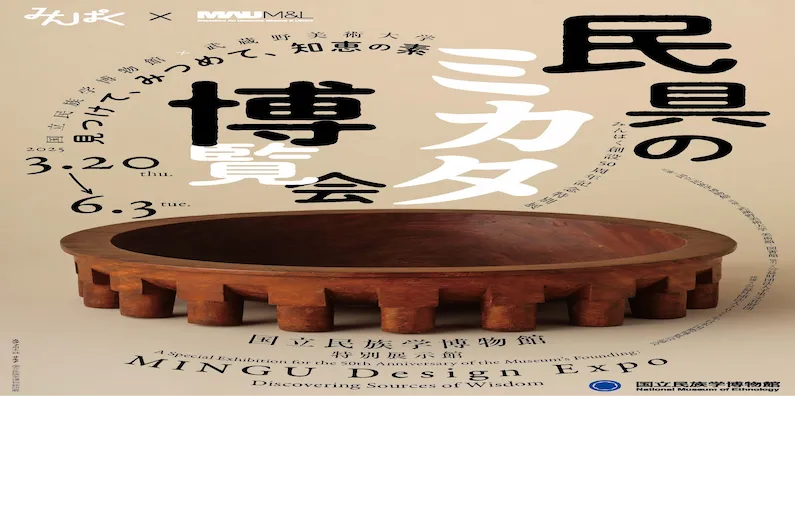Minpaku’s 50th Anniversary Special Exhibition: The Folk Tool Perspective — Discovering, Observing, and the Essence of Ingenuity (March 20 – June 3, 2024)
This special exhibition, celebrating the 50th anniversary of the National Museum of Ethnology (Minpaku), offers a unique opportunity to explore the world of folk tools. Running from March 20th (Thursday, a holiday) to June 3rd (Tuesday), 2024, "The Folk Tools Exhibition: Discovering, Observing, and the Seeds of Wisdom" presents a carefully curated selection of 1,300 items from two significant collections: the EEM Collection and the Musabi Collection.
Minpaku’s 50th Anniversary Special Exhibition
Folk tools, born from the necessities of daily life, offer a tangible connection to the ingenuity and resourcefulness of past generations. These objects, crafted and utilized for everyday tasks, provide valuable insights into the knowledge, skills, and perspectives of the people who created them. They reflect a deep understanding of readily available materials and a harmonious relationship with the natural world. Collected by researchers during their travels, these tools have become integral parts of museum collections, representing the diverse cultures they encountered.
A sake set, part of Minpaku’s collection
The exhibition draws from two distinct sources. The EEM Collection comprises folk tools from around the globe, gathered for the 1970 Osaka Expo. The Musabi Collection, held by Musashino Art University, focuses on Japanese folk tools collected during the same period. By examining these artifacts from multiple viewpoints, visitors can discover the inherent appeal of folk tools, observe the unique characteristics of each item, and explore the "seeds of wisdom" embedded within their design and function.
A repaired tesui-bachi water basin
To clarify the origins of these collections:
- EEM (EXPO ’70 Ethnological Mission): This refers to the team responsible for collecting approximately 2,500 ethnographic materials from around the world for display in the Tower of the Sun, the theme pavilion of the 1970 Osaka Expo. These objects were intended to represent the origins of humanity.
- Musabi Collection: Assembled by the Musashino Art University Institute of Daily Life Culture and the Kinki Nippon Tourist Japan Cultural Tourism Research Institute, this collection was spearheaded by the renowned folklorist Tsuneichi Miyamoto, sometimes referred to as the "Wandering Giant." It includes ceramics, bamboo crafts, and dyed textiles, representing the daily life and culture of Japan, gathered with the intention of establishing the National Museum of Ethnology in 1975.
Related Events
A series of related events will complement the exhibition, providing deeper insights into the collections and the broader context of folk tools. For detailed participation methods, please refer to the Minpaku website.
Public Symposium ①: The Genealogy of Collections
- Date and Time: March 30th (Sunday), 13:20-16:25 (Doors open at 12:30)
- Venue: Main Building 2nd Floor, Seminar Room 5
- Lecturers:
- Koji Kato (Professor, Musashino Art University)
- Zenji Jinno (President, Japan Folk-craft Association; Professor Emeritus, Musashino Art University)
- Kiyoshi Kawamura (Associate Professor, National Museum of Japanese History)
- Shingo Hidaka (Professor, National Museum of Ethnology)
- Madoka Nishi (Editor)
- Capacity: 50 attendees (in-person) / 450 attendees (online)
- Content: This symposium will trace the formation of large folk tool collections, focusing on the EEM Collection, the Musabi Collection, and the recent folk tool collection from the Oku-Noto Triennale’s "Okurazarae Project." The discussion will also address the future utilization and development of these valuable resources.
Public Symposium ②: Doing TSUNEICHI: Rereading ‘The Forgotten Japanese’
- Date and Time: April 13th (Sunday), 13:20-16:25 (Doors open at 12:30)
- Venue: Main Building 2nd Floor, Seminar Room 5
- Lecturers:
- Koji Kato (Professor, Musashino Art University)
- Katsutaka Hojo (Professor, Sophia University)
- Shisuke Yamakawa (Part-time Lecturer, Musashino Art University)
- Shingo Hidaka (Professor, National Museum of Ethnology)
- Ryusuke Kotani (Chief Leader, Center for Conservation Science)
- Capacity: 50 attendees (in-person) / 450 attendees (online)
- Content: Stemming from discussions held by the "Doing TSUNEICHI" reading group at Musashino Art University Ichigaya Campus, this symposium aims to re-examine Tsuneichi Miyamoto’s The Forgotten Japanese within its historical context. The discussion will explore the public role of contemporary humanities and the significance of museum collections, moving beyond a simple celebration of the work as a masterpiece.
Minpaku Seminar: Behind the Scenes of the Folk Tools Exhibition: EEM Collection x Musabi Collection
- Date and Time: May 17th (Saturday), 13:30-15:00 (Doors open at 13:00)
- Venue: Minpaku Intelligent Hall (Auditorium)
- Lecturers:
- Shingo Hidaka (Professor, National Museum of Ethnology)
- Atsushi Nobayashi (Professor, National Museum of Ethnology)
- Koji Kato (Professor, Musashino Art University)
- Capacity: 400 attendees
- Content: This seminar will provide an overview of the EEM and Musabi Collections featured in the special exhibition, highlighting the unique appeal of the folk tools on display.
Exhibition Details
- Dates: March 20, 2025 (Thursday, Holiday) – June 3, 2024 (Tuesday)
- Closed: Wednesdays
- Hours: 10:00-17:00 (Last entry at 16:30)
- Venue: National Museum of Ethnology, Special Exhibition Hall (10-1 Senri Expo Park, Suita City)
- Admission:
- General: ¥880
- University Students: ¥450
- High School Students and younger: Free
- Contact: 06-6876-2151 (Main)
- Website/SNS: https://www.minpaku.ac.jp/
What is Minpaku?
Minpaku, officially the National Museum of Ethnology, is a research institution and museum in Suita, Osaka, Japan. Established in 1974, it focuses on cultural artifacts and ethnological research, providing a platform for scholars and the public to explore global human cultures.
The museum houses a diverse collection of folk tools, textiles, musical instruments, and everyday objects, offering insights into various societies’ ways of life. Minpaku’s exhibitions aim to enhance understanding of cultural diversity and human creativity, serving as a resource for academic research and public education.
Beyond exhibitions, Minpaku engages in research projects and international collaborations, contributing to discussions on cultural heritage and anthropology. Its library and archives offer researchers access to extensive ethnographic materials and scholarly works.
As Minpaku marks its 50th anniversary, it continues to encourage exploration and appreciation of cultural heritage, inviting visitors to connect with the stories and traditions that define our human experience.


